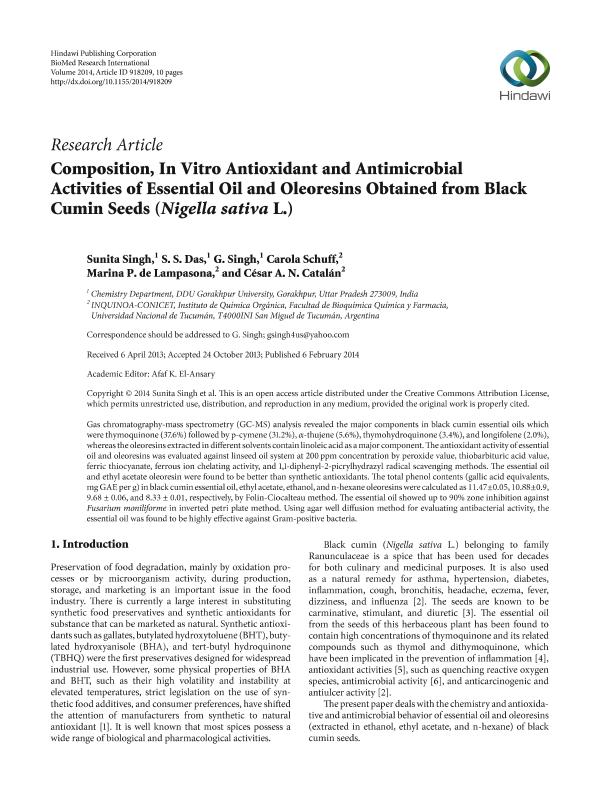Artículo
Composition, in vitro antioxidant and antimicrobial activities of essential oil and oleoresins obtained from black cumin seeds (Nigella sativa L.)
Singh, Sunita; Das, S. S.; Singh, Gurdip; Schuff, Carola; Perotti, Marina Elvira; Catalan, Cesar Atilio Nazareno

Fecha de publicación:
02/2014
Editorial:
Hindawi Publishing Corporation
Revista:
Biomed
ISSN:
2314-6133
Idioma:
Inglés
Tipo de recurso:
Artículo publicado
Clasificación temática:
Resumen
Gas chromatography-mass spectrometry (GC-MS) analysis revealed the major components in black cumin essential oils which were thymoquinone (37.6%) followed by p-cymene (31.2%), alpha-thujene (5.6%), thymohydroquinone (3.4%), and longifolene (2.0%), whereas the oleoresins extracted in different solvents contain linoleic acid as amajor component.The antioxidant activity of essential oil and oleoresins was evaluated against linseed oil system at 200 ppm concentration by peroxide value, thiobarbituric acid value, ferric thiocyanate, ferrous ion chelating activity, and 1,1-diphenyl-2-picrylhydrazyl radical scavenging methods. The essential oil and ethyl acetate oleoresin were found to be better than synthetic antioxidants.The total phenol contents (gallic acid equivalents, mg GAE per g) in black cumin essential oil, ethyl acetate, ethanol, and n-hexane oleoresinswere calculated as 11.47±0.05, 10.88±0.9, 9.68 ± 0.06, and 8.33 ± 0.01, respectively, by Folin-Ciocalteaumethod. The essential oil showed up to 90%zone inhibition against Fusarium moniliforme in inverted petri plate method. Using agar well diffusion method for evaluating antibacterial activity, the essential oil was found to be highly effective against Gram-positive bacteria.
Palabras clave:
Black Cumin Seeds
,
Essential Oil
,
Oleoresins
,
Antimicrobial
Archivos asociados
Licencia
Identificadores
Colecciones
Articulos(CCT - NOA SUR)
Articulos de CTRO.CIENTIFICO TECNOL.CONICET - NOA SUR
Articulos de CTRO.CIENTIFICO TECNOL.CONICET - NOA SUR
Citación
Singh, Sunita; Das, S. S.; Singh, Gurdip; Schuff, Carola; Perotti, Marina Elvira; et al.; Composition, in vitro antioxidant and antimicrobial activities of essential oil and oleoresins obtained from black cumin seeds (Nigella sativa L.); Hindawi Publishing Corporation; Biomed; 2014; 2-2014; 1-10
Compartir
Altmétricas



